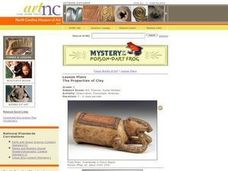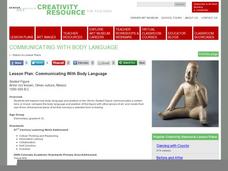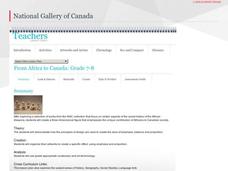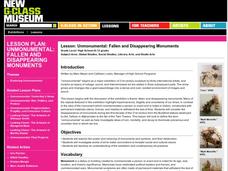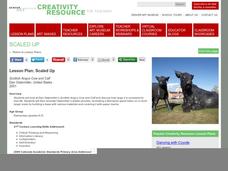Curated OER
The Properties of Clay
Sixth graders determine the physical properties of clay by examining ceramic works of art. They evaluate local soil samples for suitability for sculpting and compare clay taken from soil to manufactured clay.
Curated OER
Lesson: Proposal for a School Sculpture
After discussing the artistic elements and design process needed to construct the modern sculpture, Lao Tzu, kids get logical. They consider the purposeful use of space in the sculpture, design a modern piece for a specific space at...
Curated OER
Lesson: Animal Journeys
Here is a great way to get the brain going. Children look at an image of the sculpture, Jar and then imagine what an animal would look like as it moved inside the sculpture. They then use clay and cookie cutters to create a...
Curated OER
Lesson: Emphasis on Exaggeration
His ears, head, and designs are all an exaggerated form of art. Learners examine a South American sculpture in terms of how exaggeration was used to convey meaning. They then work through the design process as they create similarly...
Curated OER
Lesson Plan: Communicating With Body Language
The Olmec were an ancient people native to Mexico who lived from 1000-500 BC. Young artists examine the Olmec piece Seated Figure to analyze the use of body language to communicate a tone or feeling. They then use clay or play-dough to...
Curated OER
Lesson: Skin Fruit: Ideas of Empathy in Janine Antoni's Work
Kids get artistic as they explore the impact of art materials, sculpture, and performance. They discuss the work of Janine Antoni and then create a performance piece that reflects social or global issues they feel strongly about. The end...
National Gallery of Canada
The Body Tells Its Story
Incorporate sculpture into your art curriculum. To start, pupils discuss the artistic process and topics of marginalization. With the discussion in mind, individuals select images to inspire sculptures of people that they will present to...
National Gallery of Canada
Class Commission
Simulate a real-life situation with a project proposal activity for an art installation. Learners look at work by Joe Fafard and examine his website for information about public art displays. They also search for other proposals for...
National Gallery of Canada
One Look Is Worth A Thousand Words
Facial expressions can communicate complex emotions. Examine expressions in several hyperrealistic works of art before beginning a project. Learners will create their own clay faces that show an emotion using either photos or their own...
National Gallery of Canada
Reading Sculptures
Consider the elements and principles of design closely while examining works of art. Learners select an image from the provided pieces to write about in relation to the elements and principles of design. They then sketch and sculpt their...
National Gallery of Canada
The Ideal Trophy
Invite your pupils to represent a club, team or other group with a trophy of their own creation. Learners examine the Taylor Cup by Laurent Amiot and then prepare trophy designs. When the sketches are complete, pupils sculpt the final...
National Gallery of Canada
The World Around Me
Have your learners use their surroundings as inspiration for an art project. Class members first examine and discuss art. They then choose an area and spend five days taking down observations in written and sketch form. These...
National Gallery of Canada
From Africa to Canada
Represent the African diaspora with figurines. Using a discussion on the contributions of people of African descent as inspiration, class members prepare sketches of a figure and put together a small sculpture from those sketches.
National Gallery of Canada
The Roots of My Family
Represent family history visually by requiring your young artists to create family trees that express balance and symmetry. Pupils examine works of art, research their family histories, and put together large family tree posters.
National Gallery of Canada
Artful Emotions
Blue is sad, and red is angry, but why is that? Young artists explore the expression of emotions through art by observing and creating artwork. Starting with a questioning session about images of art, this plan moves into a sculpture...
National Gallery of Canada
Build Me a Legend
Legends are full of imagery and action. Transfer a scene from a legend to a three-dimensional art piece. Class members first view Inuit art and discuss legends. They then build scenes that include action, setting, and characters.
TED-Ed
A Brief History of Religion in Art
Did you know that some languages have no word for art? The English language does and the narrator of this short video discusses the aesthetic dimension of religious art as it "visually communicates meaning beyond language."
New Museum of Contemporary Art
Lesson: Unmonumental: Fallen and Disappearing Monuments
Due to vandalism, war, and urban decay, many of the world's great monuments have fallen to ruin. Here is an interesting instructional activity that increases understanding of the dichotomy between what are intended as lasting tributes,...
Curated OER
Sculpture in Balance
Students discuss the difference betwen two-dimensional vs. three-dimensional art. In this art lesson, students discuss what symmetry or balance is in art and construct a symmetrical and an asymmetrical mobile.
Curated OER
Ancient Gold Working
Students create a sculpture inspired by the masks, pendants, or human and animal forms found in ancient Indian art of the Americas. They focus on the techniques of metalworking, especially repousse.
Curated OER
Lesson: Expressing the Inner Life of Things
Found metal objects were welded together to create an inspiring African sculpture. Learners consider the use of objects and the inspiration of African art seen in Picasso's work. They then find and create a scrap art sculpture, as well...
Curated OER
Lesson: Scaled Up
Do you ever think about what it takes for an artist to create a larger-than-life sculpture? Kids examine the piece, Scottish Angus Cow and Calf as it relates to scale, scale conversion, and artistic craft. They then use scale conversions...
Curated OER
Lesson: Creating a Superhero Sculpture
Indian art depicts an amazing pantheon of gods and goddesses, each having interesting powers and purposes. Young art historians use the provided images to analyze a carved sculpture of a monkey-god. They then brainstorm the attributes...
Curated OER
Diving Whale Sculpture
Students identify two types of whales: toothed whales and baleen whales, and understand that whales come to the surface for air. Then they recognize that whales are mammals (they nurse their young and are warm-blooded). Students also...


